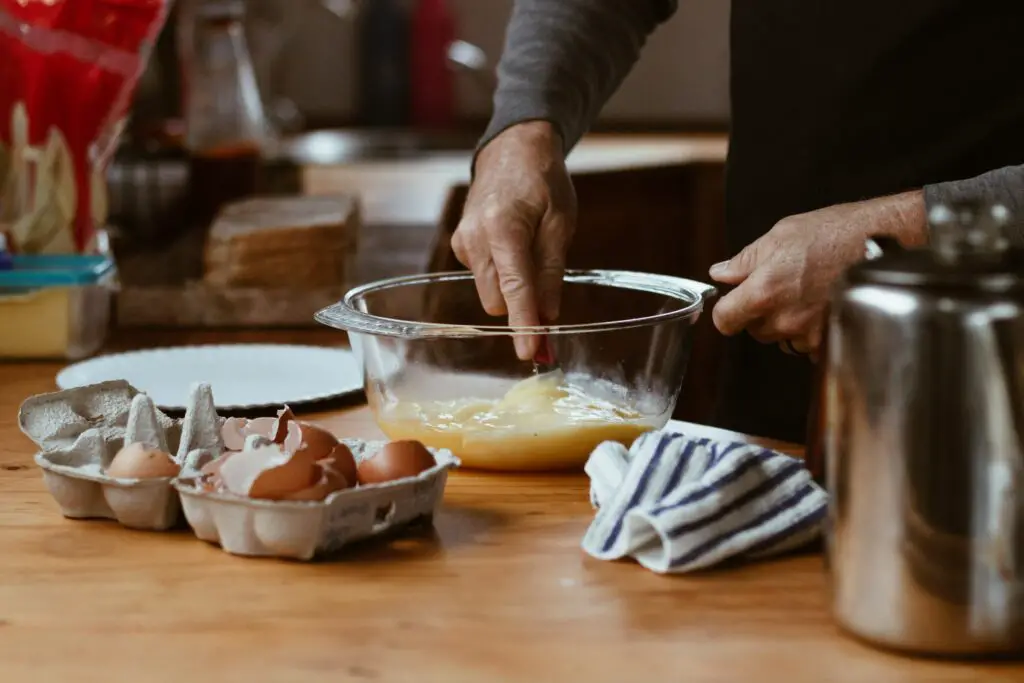Flour looks plain, but it’s the foundation of every cookie, cake, or loaf you pull from the oven. Pick the wrong kind, and your bread might sink or your cake could turn chewy.
Pick the right one, and suddenly everything just works. In this guide, we’ll break down the most common flours, what makes them different, and exactly how to use them for baking wins every time.
The Basics of Flour
At its core, flour is simply ground grain, most often wheat, though plenty of other grains can join the party.
What makes flour fascinating is what’s inside: starch, which gives structure; protein, which forms gluten when mixed with water; and in less refined flours, the bran and germ, which add flavor, nutrition, and a bit of rustic charm.
The protein content is the real game-changer—it’s the difference between a chewy sourdough that fights back when you bite into it and a soft, tender cake that melts on your tongue.
High-protein flours create strong gluten networks, perfect for breads that need to rise tall and hold their shape, while low-protein flours keep things delicate, letting pastries and cakes stay fluffy instead of tough.
Once you understand this balance, choosing the right flour feels less like guesswork and more like having a secret baking superpower.
Common Types of Flour and Their Uses
A. All-Purpose Flour
All-purpose flour earns its name honestly—it really can do just about everything.
With a moderate protein content of 9–11%, it’s versatile enough to give cookies structure without making them tough and muffins enough body without weighing them down.
Think of it as the “Swiss army knife” of the baking world.
If you only keep one kind of flour in your kitchen, this is the one that will bail you out when a late-night pancake craving strikes or when you need a quick loaf of banana bread.
B. Bread Flour
Bread flour is the powerhouse of the flour family, packing 12–14% protein. That means more gluten, which translates to stretchy dough that rises high and bakes into chewy loaves with a golden crust.
It’s the secret behind bagels that fight back when you bite them and pizza crusts with that perfect balance of crisp and chew.
Try swapping it for all-purpose in your favorite bread recipe, and you’ll instantly notice the difference in height and texture.
C. Cake Flour
Cake flour is all about delicacy. With only 7–9% protein, it produces little gluten, which makes for soft, melt-in-your-mouth bakes.
Its fine texture feels almost silky, and it’s the flour behind those tall, fluffy layer cakes and cupcakes that don’t collapse under their own weight.
Use it for recipes that demand tenderness over strength, like sponge cakes or airy pastries. But beware—use it in bread and you’ll end up with a sad, flat loaf.
D. Pastry Flour
Pastry flour lives in the middle ground, with 8–9% protein. It’s stronger than cake flour but softer than all-purpose, making it a go-to for bakers who want flakiness without toughness.
Think buttery pie crusts, tender biscuits, and scones that crumble just right. If you’ve ever struggled to get pastry that’s flaky instead of rubbery, pastry flour might be your golden ticket.
E. Whole Wheat Flour
Whole wheat flour includes the bran and germ, which means more fiber, nutrients, and flavor. The tradeoff? It’s denser and can make baked goods heavier.
That nutty taste, though, makes breads, hearty muffins, and rustic pancakes shine.
If you’re new to whole wheat, start by replacing half of the all-purpose in your recipe and work your way up—it gives you the nutrition boost without turning your cookies into bricks.
F. Self-Rising Flour
Self-rising flour is basically a baking shortcut. It’s just all-purpose flour mixed with baking powder and salt, so the leavening power is already built in.
Southern bakers love it for biscuits because it takes out the guesswork. It also works wonders for quick breads and pancakes when you’re in a hurry.
Just don’t forget—it’s not interchangeable in every recipe, so read carefully before making the swap.
G. Specialty & Alternative Flours
Beyond the basics, there’s a world of specialty and alternative flours. Rye flour brings a rich, earthy flavor to breads. Spelt offers a lighter, slightly sweet taste. Oat flour adds a soft, chewy texture to cookies.
Nut-based flours like almond and coconut are gluten-free favorites, though they behave differently in recipes and often need adjustments.
Then there are gluten-free blends, designed to mimic the structure of wheat flour while catering to dietary needs.
These flours open doors to unique flavors and textures, and while they may take some experimenting, they can completely transform your baking.
How to Choose the Right Flour
Choosing the right flour comes down to matching its protein content with what you want your bake to become—high protein for structure and chew, low protein for softness and tenderness.
Bread flour is perfect when you need strength for tall loaves or chewy crusts, while cake or pastry flour shines in recipes that should stay light and delicate.
Substitutions can work in a pinch, but they’re not always a straight swap—using all-purpose instead of bread flour may give you decent bread, just less chewy, and swapping cake flour for all-purpose can make cookies spread too thin.
Sometimes, the smartest move is mixing flours to strike a balance: blending whole wheat with all-purpose gives you a nutty flavor without the heaviness, or combining bread flour with all-purpose gives pizza dough the perfect chew without being too tough.
Once you start thinking of flour like a toolkit instead of a one-size-fits-all ingredient, your baking takes on a whole new level of control and creativity.
Storage Tips for Flour
Shelf Life of White vs. Whole Grain Flours
Not all flours age the same. White flours like all-purpose, bread, and cake flour can last up to a year if stored well because the bran and germ are removed, leaving just the starchy core.
Whole-grain flours, on the other hand, contain oils from the bran and germ that spoil faster, often within three to six months.
That nutty flavor you love in whole wheat can quickly turn bitter if the flour goes rancid. So, the fresher the flour, the better the bake.
Proper Storage
Think of flour like a pantry diva—it hates light, heat, and moisture. The best way to keep it happy is in an airtight container, stored in a cool, dark place.
That keeps out pests (because no one wants surprise protein in their muffins) and protects against humidity that can cause clumps or mold. Glass jars, plastic bins, or even heavy-duty freezer bags work wonders.
And always label your containers with the type of flour and the date you bought it—your future self will thank you.
Freezing Flour to Extend Freshness
If you don’t bake often or you’ve stocked up during a sale, the freezer is your secret weapon. Freezing flour can double or even triple its shelf life without changing how it performs in recipes.
Just make sure it’s in a sealed, airtight container to avoid absorbing odors (unless you’re aiming for garlic-scented cookies, which I don’t recommend).
When you’re ready to use it, bring the flour back to room temperature before mixing, so your dough doesn’t get a shock from the cold. It’s a simple trick that keeps your baking ingredients fresh and reliable.
Common Baking Mistakes with Flour
Over-Measuring vs. Under-Measuring
One of the easiest ways to sabotage your baking is by scooping flour straight from the bag with a cup. It packs the flour down, giving you way more than the recipe intended.
Too much flour means dry cookies, dense cakes, and bread that could double as a paperweight. Too little, and your dough might spread into sad pancake-like blobs.
The best solution? Use a kitchen scale. Weighing flour is accurate, repeatable, and saves you from the “mystery results” that come with eyeballing.
If you don’t have a scale, the next best method is to spoon the flour into the measuring cup and level it off with a knife—gentle, no scooping, no packing.
Using Bread Flour in Cake
It’s tempting to swap flours when you’re short on ingredients, but some swaps backfire.
Using bread flour in a cake recipe, for example, often leads to a rubbery, chewy texture that feels more like a bagel than a birthday treat.
Bread flour has a higher protein content, which builds strong gluten networks—great for structure, terrible for tenderness.
Cakes require a lower-protein flour, such as cake flour or even all-purpose flour, to remain soft and airy. In short, bread flour is suited for pizza, not for chocolate cake.
Ignoring Expiration Dates
Flour may look harmless, but it doesn’t last forever. White flour can hold out for up to a year, but whole wheat or specialty flours spoil quickly because of the oils in the bran and germ.
Ignoring expiration dates means you risk funky, bitter flavors sneaking into your bakes. If your flour smells musty, sour, or just “off,” toss it—no recipe is worth ruining with stale ingredients.
Fresh flour gives better flavor, better texture, and ensures your hard work pays off with a bake that tastes the way it should.
Final Words
Flour isn’t a one-size-fits-all ingredient—it’s the steering wheel that drives your bake in the right direction. The fun part is experimenting.
Try swapping flours and notice how the same recipe transforms in texture, taste, and rise.
Next time you bake, grab two different flours, run the same recipe, and compare the results—you’ll learn faster than any cookbook could teach you.
FAQs
Can I substitute bread flour for all-purpose?
Yes, but expect changes. Bread flour has more protein, so it creates chewier textures. Your cookies might be thicker and your bread taller, but cakes and muffins could turn tough.
What’s the difference between bleached and unbleached flour?
Bleached flour is chemically treated to speed up aging, giving it a softer texture and whiter color. Unbleached flour ages naturally, with a slightly denser grain and creamier tone.
Both work fine, but unbleached is often preferred for heartier bakes.
Is gluten-free flour a 1:1 substitute?
Not always. Some gluten-free blends are designed for direct swaps, but many need added binders like xanthan gum or recipe tweaks. Without adjustments, your baked goods may crumble or fall flat.
Why does whole wheat flour make baked goods denser?
The bran and germ in whole wheat cut through gluten strands, making doughs less stretchy. That means less rise and a denser texture. Mixing whole wheat with all-purpose flour lightens things up.
How do I measure flour correctly?
For best accuracy, use a kitchen scale. If you’re measuring by cup, spoon the flour into the cup and level it with a knife—never scoop directly from the bag.
Scooping packs in extra flour, which can throw off your recipe.



